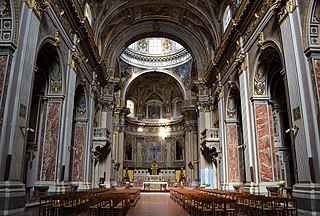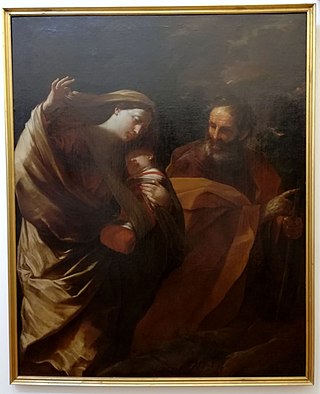
Sant'Anna dei Lombardi,, and also known as Santa Maria di Monte Oliveto, is an ancient church and convent located in piazza Monteoliveto in central Naples, Italy. Across Monteoliveto street from the Fountain in the square is the Renaissance palace of Orsini di Gravina.

San Gennaro dei Poveri is a former monastery and church complex, later converted into a hospital for indigent located on Via San Gennaro dei Poveri #25 in the Rione Sanità, of the city of Naples, Italy. The elongated complex rises towards Capodimonte, lying just south of the domed Basilica dell'Incoronata Madre del Buon Consiglio.

Pendino is one of the 30 quartieri of Naples, southern Italy.

Fabrizio Santafede or Fabrizio Santaféde was an Italian painter known for his altarpieces. He painted in a style that rejected the Mannerism popular in the Naples of his time and evident in the works of Francesco Curia.

The University of Naples "L'Orientale" is a university located in Naples, Italy. Founded in 1732 by Matteo Ripa, it is the oldest school of Sinology and Oriental Studies of the European continent. It is organized in three departments, and is the main university in Italy specializing in the study of non-European languages and cultures, with research and studies agreements with universities all over the world. It is one of the top universities in the world regarding Asian cultures and languages.

The Ospedale degli Incurabili or Complesso degli Incurabili is an ancient and prominent hospital complex located on Via Maria Longo in central Naples, Italy. Part of the complex, including the remarkable pharmacy, are now the Museo delle arti sanitarie of Naples.

The Basilica of Santa Maria della Sanità is a basilica church located over the Catacombs of San Gaudioso, on a Piazza near where Via Sanità meets Via Teresa degli Scalzi, in the Rione of the Sanità, in Naples, Italy. The church is also called San Vincenzo or San Vincenzo della Sanità, due to the cult of an icon of San Vincenzo Ferrer, also called locally O' Monacone.

Santi Apostoli is a Baroque-style church in Naples, Italy.

The church of the Santissima Trinità alla Cesarea is a Baroque-style church, located in Piazetta Trinità alla Cesarea, in central Naples, Italy.

San Giacomo degli Italiani is a church located on Via Depretis in Naples, Italy.

Santa Maria Donnaromita is a former church located on via Paladino in Naples.

The Basilica of San Giovanni Maggiore is a church in Largo San Giovanni Maggiore in central Naples, Italy.

The church of Santi Severino e Sossio and the annexed monastery are located on via Bartolommeo Capasso in Naples, Italy.
Arcangelo Guglielmelli was an Italian architect and painter, active in his native Naples, Italy, in a late-Baroque style. He was involved in the building and reconstruction of churches, many of which had been damaged by the earthquakes of 1688 and 1694.
Giovanni Pandozzi was an Italian painter.

Santa Maria dei Vergini is a church in central Naples, Italy, in the Rione of the Sanità.
The chapel of Santa Maria a Sicola is a small Roman Catholic medieval chapel, off Via Giudecca Vecchia, in the neighborhood of Forcella, in the Quartieri Pendino of Naples, Italy.

The Flight into Egypt is a c. 1622 oil on canvas painting by Guido Reni in the Girolamini, Naples in Naples.

The Vico, and Vicoletto, dei Zuroli, also called Vicolo dei Zurli are two historic alleys in the city of Naples, they are located near via Forcella in the historic center of the city, they are located near via Forcella and near the church of Pio Monte della Misericordia, between Via dei Tribunali and Via Vicaria Vecchia, in the Pendino district.

Carlo Celano was an Italian lawyer and man of letters, who led the restoration of the church of Santa Restituta in his birthplace of Naples and left an accurate census of the city's monuments, updated up to the end of the 17th century.




















